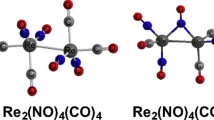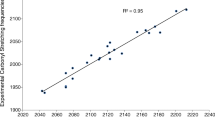Abstract
The lowest energy Ir4(CO)12 structure is predicted by density functional theory to be a triply bridged structure analogous to the experimental structures for its lighter congeners M4(CO)9(μ-CO)3 (M=Co, Rh). The experimental unbridged structure for Ir4(CO)12 is predicted to lie ~6 kcal/mol above the triply bridged structure. However, the MP2 method predicts the unbridged structure for Ir4(CO)12 to be the lowest energy structure by ~9 kcal/mol over the triply bridged structure. The lowest energy Ir4(CO)11 structure is predicted to be a doubly bridged structure with a central tetrahedral Ir4 unit. A higher energy Ir4(CO)11 structure at ~18 kcal/mol above this global minimum is found with an unusual μ4-CO group bridging all four atoms of a central Ir4 butterfly. This Ir4(CO)8(μ-CO)2(μ4-CO) structure is analogous to the lowest energy Co4(CO)11 structure found in a previous theoretical study, as well as Rh4(CO)4(μ-CO)4(PBu t3 )2(PtPBu t3 )(μ4-CO), which has been synthesized by Adams and coworkers. The Ir4 tetrahedron is remarkably persistent in the more highly unsaturated Ir4(CO) n (n = 10, 9, 8) structures with relatively little changes in the Ir–Ir distances as carbonyl groups are removed. This appears to be related to the spherical aromaticity in the tetrahedral Ir4 structures.






Similar content being viewed by others
References
Hieber W, Lagally HZ (1940) Anorg Chem 245:321
Chaston SHH, Stone FGA (1969) J Chem Soc A, 500
Whyman R (1972) J Chem Soc Dalton 2294
Malatesta L, Caglio G, Angoletta M (1972) Inorg Syn 13:95
Stuntz GF, Shapley JR (1976) Inorg Nucl Chem Lett 12:49
Churchill MR, Hutchinson JP (1978) Inorg Chem 17:3528
Wei CH, Dahl LFJ (1966) Am Chem Soc 88:1821
Wei CH (1969) Inorg Chem 8:2384
Farrugia LJJ (2000) Cluster Sci 11:39
Dahlinger K, Falcone F, Poë AJ (1986) Inorg Chem 25:2654
Zhang X, Li Q-s, Xie Y, King RB, Schaefer HF (2008) Eur J Inorg Chem, 2158
Adams RD, Captain B, Pellechiaq PJ, Smith JL (2004) Inorg Chem 43:2695
Li Q-s, Xu B, Xie Y, King RB, Schaefer HF (2007) Dalton Trans 4312
Xu B, Li Q-S, Xie Y, King RB, Schaefer HF (2008) Dalton Trans, 1366
Ehlers AW, Frenking GJ (1994) Am Chem Soc 116:1514
Li J, Schreckenbach G, Ziegler TJ (1995) Am Chem Soc 117:486
Jonas V, Thiel WJ (1995) Chem Phys 102:8474
Brynda M, Gagliardi L, Wimark PO, Power PP, Roos BO (2006) Angew Chem Int Ed 45:3804
Zhao Y, Truhlar DG (2006) J Chem Phys 124: 224105
Niu S, Hall MB (2000) Chem Rev 100:353
Buhl M, Kabrede H (2006) J Chem Theory Comput 2:1282
Becke AD (1988) Phys Rev A 38:3098
Perdew JP (1986) Phys Rev B 33:8822
Adamo C, Barone VJ (1998) Chem Phys 108:664
Feng X, Gu J, Xie Y, King RB, Schaefer HFJ (2007) Chem Theory Comput 3:1580
Møller C, Plesset MS (1934) Phys Rev 46:618
Pople JA, Binkley JS, Seeger R (1976) Int J Quantum Chem Symp 10:1
Andrae D, Haussermann U, Dolg M, Stoll H, Preuss H (1990) Theor Chim Acta 77:123
Bergner A, Dolg M, Kuechle W, Stoll H, Preuss H (1993) Mol Phys 80:1431
Dunning THJ (1970) Chem Phys 53:2823
Huzinaga SJ (1965) Chem Phys 42:1293
Frisch MJ et al. (2004) Gaussian 03, Revision C 02; Gaussian, Inc.; Wallingford CT (see Supporting Information for details)
Papas BN, Schaefer HFJ (2006) Mol Struct 768:175
Silaghi-Dumitrescu I, Bitterwolf TE, King RBJ (2006) Am Chem Soc 128:5342
Jonas V, Thiel W (1995) J Chem Phys 102:8474
Wei CH, Wilkes GR, Dahl LFJ (1967) Am Chem Soc 89:4792
Hartwig J (2009) Organotransition metal chemistry: from bonding to catalysis. University Science Books, Sausalito, CA
Crabtree RH (2009) The organometallic chemistry of the transition metals, 5th edn. Wiley, New York, pp 25–32
Hirsch A, Chen Z, Jiao H (2001) Angew Chem Int Ed 40:2834
Chen Z, King RB (2005) Chem Rev 105:3613
Weinhold F, Landis CR, Valency Bonding (2005) A natural bond order donor-acceptor perspective. Cambridge University Press, Cambridge
Sunderlin LS, Wang D, Squires RRJ (1993) Am Chem Soc 115:12060
Acknowledgments
We are indebted to the Scientific Research Fund of State Key Laboratory of Explosion Science and Technology (2DkT10-01a) and the Research Fund for the Doctoral Program of Higher Education (20104407110007) of China as well as the U. S. National Science Foundation (Grants CHE-0716718 and CHE-1054286) for support of this research.
Author information
Authors and Affiliations
Corresponding authors
Additional information
Dedicated to Professor Shigeru Nagase on the occasion of his 65th birthday and published as part of the Nagase Festschrift Issue.
Electronic supplementary material
Below is the link to the electronic supplementary material.
214_2011_1005_MOESM1_ESM.pdf
Tables S1–S17: Theoretical harmonic vibrational frequencies for the Ir4(CO) n (n = 12, 11, 10, 9, and 8) structures using the BP86 and MPW1PW91 methods; Tables S18–S34: Theoretical Cartesian coordinates for the Ir4(CO) n (n = 12, 11, 10, 9, and 8) structures using the BP86 method; Table S35: Wiberg bond indices for the Ir–Ir interactions in selected Ir4(CO) n structures (n = 12, 11, 10, 9, and 8) using the three DFT methods; Complete Gaussian reference (reference 32). (PDF 275 kb)
Rights and permissions
About this article
Cite this article
Chi, Q.K., Li, Qs., Xie, Y. et al. Unsaturation in homoleptic tetranuclear iridium carbonyls: a comparison of density functional theory with the MP2 method in metal cluster structures. Theor Chem Acc 130, 393–400 (2011). https://doi.org/10.1007/s00214-011-1005-x
Received:
Accepted:
Published:
Issue Date:
DOI: https://doi.org/10.1007/s00214-011-1005-x




